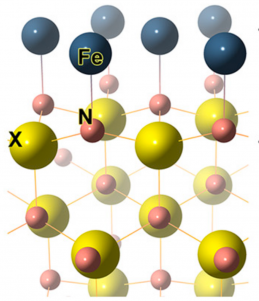A future ultraminiature computer the size of a pinhead?
April 16, 2018

Thin-film MRAM surface structure comprising one-monolayer iron (Fe) deposited on a boron, gallium, aluminum, or indium nitride substrate. (credit: Jie-Xiang Yu and Jiadong Zang/Science Advances)
University of New Hampshire researchers have discovered a combination of materials that they say would allow for smaller, safer magnetic random access memory (MRAM) storage — ultimately leading to ultraminiature computers.
Unlike conventional RAM (read-only memory) SRAM and DRAM chip technologies, with MRAM, data is stored by magnetic storage elements, instead of energy-expending electric charge or current flows. MRAM is also nonvolatile memory (the data is preserved when the power if turned off). The elements are formed from two ferromagnetic plates, each of which can hold a magnetization, separated by a thin insulating layer.
In their study, published March 30, 2018 in the open-access journal Science Advances, the researchers describe a new design* comprising ultrathin films, known as Fe (iron) monolayers, grown on a substrate made up of non-magnetic substances — boron, gallium, aluminum, or indium nitride.
Ultrahigh storage density
The new design has an estimated 10-year data retention at room temperature. It can “ultimately lead to nanomagnetism and promote revolutionary ultrahigh storage density in the future,” said Jiadong Zang, an assistant professor of physics and senior author. “It opens the door to possibilities for much smaller computers for everything from basic data storage to traveling on space missions. Imagine launching a rocket with a computer the size of a pin head — it not only saves space but also a lot of fuel.”
MRAM is already challenging flash memory in a number of applications where persistent or nonvolatile memory (such as flash) is currently being used, and it’s also taking on RAM chips “in applications such as AI, IoT, 5G, and data centers,” according to a recent article in Electronic Design.**
* A provisional patent pending has been filed by UNHInnovation. This work was supported by the U.S. Department of Energy, Office of Science, Basic Energy Sciences.
** More broadly, MRAM applications are in consumer electronics, robotics, automotive , enterprise storage, and aerospace & defense, according to a market analysis and 2018–2023 forecast by Market Desk.
Abstract of Giant perpendicular magnetic anisotropy in Fe/III-V nitride thin films
Large perpendicular magnetic anisotropy (PMA) in transition metal thin films provides a pathway for enabling the intriguing physics of nanomagnetism and developing broad spintronics applications. After decades of searches for promising materials, the energy scale of PMA of transition metal thin films, unfortunately, remains only about 1 meV. This limitation has become a major bottleneck in the development of ultradense storage and memory devices. We discovered unprecedented PMA in Fe thin-film growth on the  N-terminated surface of III-V nitrides from first-principles calculations. PMA ranges from 24.1 meV/u.c. in Fe/BN to 53.7 meV/u.c. in Fe/InN. Symmetry-protected degeneracy between x2 − y2 and xy orbitals and its lift by the spin-orbit coupling play a dominant role. As a consequence, PMA in Fe/III-V nitride thin films is dominated by first-order perturbation of the spin-orbit coupling, instead of second-order in conventional transition metal/oxide thin films. This game-changing scenario would also open a new field of magnetism on transition metal/nitride interfaces.
N-terminated surface of III-V nitrides from first-principles calculations. PMA ranges from 24.1 meV/u.c. in Fe/BN to 53.7 meV/u.c. in Fe/InN. Symmetry-protected degeneracy between x2 − y2 and xy orbitals and its lift by the spin-orbit coupling play a dominant role. As a consequence, PMA in Fe/III-V nitride thin films is dominated by first-order perturbation of the spin-orbit coupling, instead of second-order in conventional transition metal/oxide thin films. This game-changing scenario would also open a new field of magnetism on transition metal/nitride interfaces.